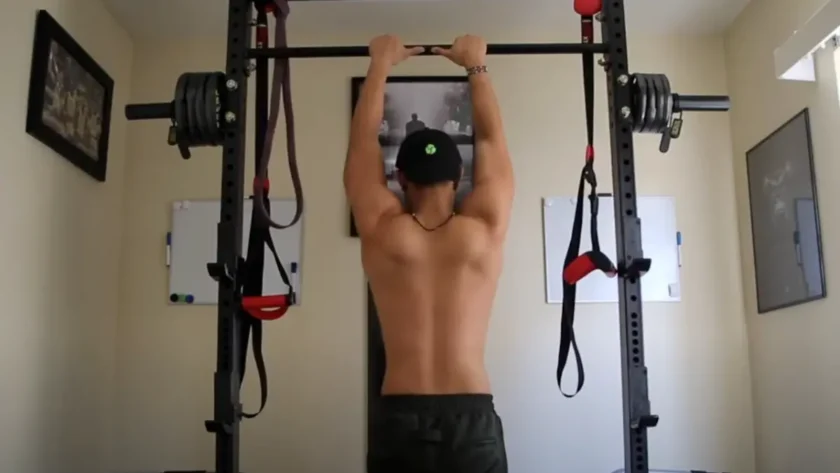The pull-up is widely regarded as one of the most effective exercises for developing upper body strength, specifically the back muscles. It primarily targets the latissimus dorsi, the broad muscles that give the back its width, while also engaging the shoulders, arms, and core.
What makes the pull-up stand out is its versatility, especially when you vary your grip. The two most popular variations—wide grip and close grip pull-ups—each bring distinct advantages, allowing you to tailor your workout for maximum results.
Contents
Wide Grip Pull-Ups: Targeting Upper Lats for Width
Wide-grip pull-ups, executed by positioning your hands beyond shoulder-width, predominantly activate the latissimus dorsi (lats). This variation is the architect behind the coveted V-shaped back, sculpting a broader, more imposing physique.
This grip emphasizes shoulder adduction, demanding heightened engagement from upper back muscles, including the teres major, infraspinatus, and trapezius. The wide grip naturally limits bicep and chest involvement, forcing the lats and upper back to bear the brunt of the work. Consequently, wide-grip pull-ups excel at enhancing overall back strength and cultivating an impressive, muscular aesthetic.
The wider hand placement intensifies the strain on the upper lats, making it the go-to choice for those aiming to maximize back width. This increased difficulty stems from greater isolation of the upper lats compared to its close-grip counterpart.
However, the wide grip comes with caveats. It can exert additional stress on the shoulders due to the constrained elbow range of motion, potentially challenging individuals with shoulder mobility concerns. These factors contribute to wide-grip pull-ups being classified as a more advanced variation, requiring impeccable form for safe and effective execution.
Muscle Emphasis:
- Primary Muscles: Latissimus dorsi, teres major, trapezius
- Secondary Muscles: Posterior deltoids, forearms, biceps
Advantages:
- Enhanced Back Width: The wide hand placement isolates the upper lats more effectively, contributing to the broad, wing-like appearance of the back.
- Superior Lat Engagement: Since the wide grip minimizes the involvement of the arms and chest, the lats do most of the heavy lifting, leading to stronger and more pronounced back muscles.
- Improved Shoulder Stability: Regular performance of wide-grip pull-ups can improve shoulder mobility and overall stability.
Challenges:
- Increased Shoulder Stress: The wider grip can place greater stress on the shoulder joints, especially for individuals with limited shoulder mobility.
- Higher Difficulty Level: Wide-grip pull-ups are generally more challenging due to the limited involvement of the biceps, making them a more advanced variation. Beginners may find this variation difficult to master initially.
Close Grip Pull-Ups: Focusing on Lower Lats for Thickness
Close-grip pull-ups, performed with hands at or narrower than shoulder-width, redirect emphasis towards the biceps and pectoralis major. This grip alters the movement pattern, causing your arms to travel posteriorly rather than medially during the ascent.
This variation preferentially targets the lower fibers of the latissimus dorsi, contributing significantly to back thickness and comprehensive muscular development.
Close grip pull-ups offer a dual benefit: they not only zero in on the lower lats but also recruit a greater proportion of your biceps compared to their wide-grip counterparts. This unique engagement pattern presents a fresh challenge and makes close grip pull-ups ideal for those seeking to develop their lower lats and enhance overall back density.
Close-grip pull-ups are notably more shoulder-friendly than wide-grip variations, making them an excellent starting point for beginners or individuals managing shoulder discomfort. Furthermore, the increased assistance from biceps and chest muscles typically allows for higher repetition counts, promoting improved muscular endurance and hypertrophy in these regions.
Muscle Emphasis:
- Primary Muscles: Biceps brachii, latissimus dorsi (lower fibers), brachialis, pectoralis major
- Secondary Muscles: Forearms, upper back (rhomboids, trapezius), posterior deltoids
Advantages:
- Enhanced Arm Development: The closer hand positioning increases the elbow flexion, allowing the biceps to play a larger role. This makes close grip pull-ups highly effective for building arm size and strength.
- Increased Repetition Potential: Because of the additional assistance from the biceps and chest muscles, many individuals find they can perform more repetitions compared to wide grip pull-ups.
- Shoulder-Friendly: Close grip pull-ups place less stress on the shoulder joints, making them a better option for those with shoulder discomfort or limited mobility.
Challenges:
- Reduced Lat Focus: While close grip pull-ups still engage the lats, the emphasis shifts towards the arms and chest, making them less effective for back width than wide grip pull-ups.
- Potential Elbow Stress: The closer grip may increase the strain on the elbows, particularly during the descent of the movement.
Wide Grip vs. Close Grip: How to Choose
Deciding between wide-grip and close-grip pull-ups depends on your specific goals and fitness level:
- If you’re aiming to build back width and target the upper lats, wide-grip pull-ups are the ideal choice.
- For those looking to increase arm strength and develop back thickness, close-grip pull-ups are more effective.
Beginners should start with close-grip pull-ups, as they place less strain on the shoulders and allow more assistance from the biceps and chest. As you become stronger, integrating wide-grip pull-ups into your routine can help enhance overall upper body strength.
Incorporating Both Variations into Your Routine
To maximize upper body development, incorporate both wide and close grip pull-ups into your routine. Here’s a suggested approach based on skill level:
- Beginners: Focus on mastering close grip pull-ups to build arm and shoulder strength. Use resistance bands or an assisted pull-up machine if necessary to ensure proper form.
- Intermediate: Add wide grip pull-ups to your workout once you’ve built a solid strength base. Aim for 2-3 sets of each variation for balanced development.
- Advanced: Increase intensity by adding weight with a belt or experimenting with more challenging progressions, such as one-arm pull-ups.
Conclusion
Both wide and close-grip pull-ups are essential for building a well-rounded back and upper body. Wide-grip pull-ups excel at building back width, while close-grip pull-ups offer a focus on back thickness and arm development.
Incorporating both variations into your routine ensures balanced muscle development and strength, allowing you to reap the full benefits of this versatile exercise.




